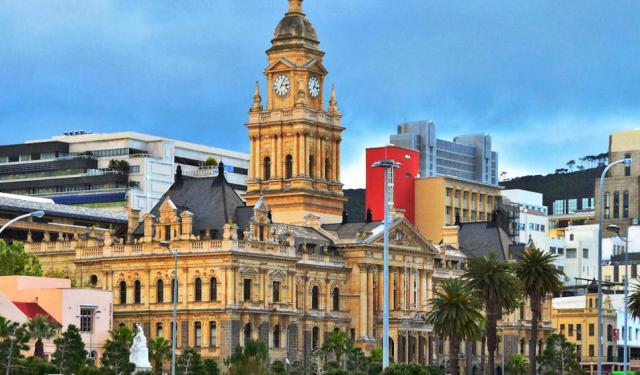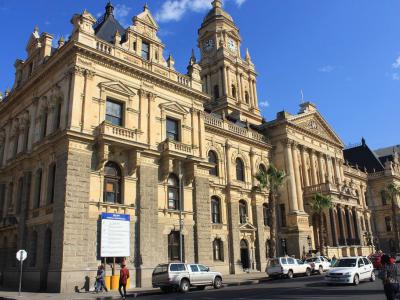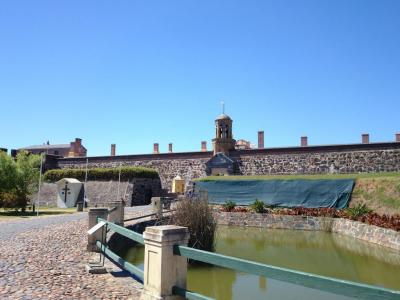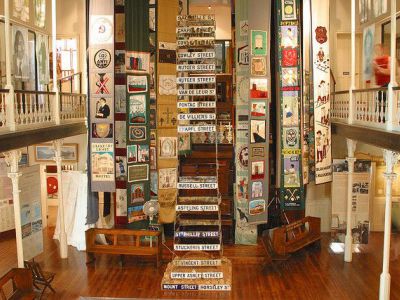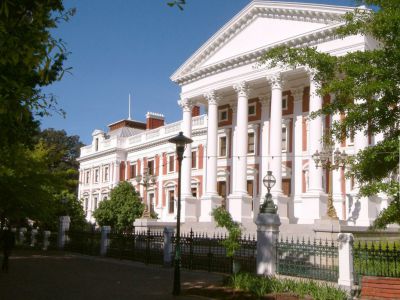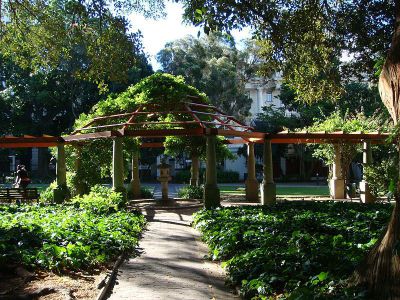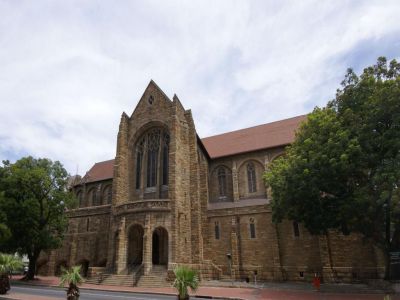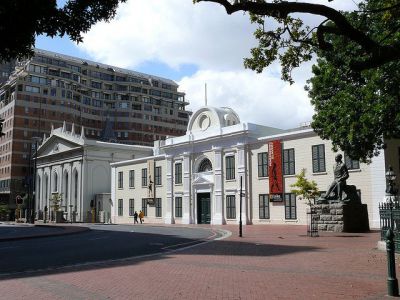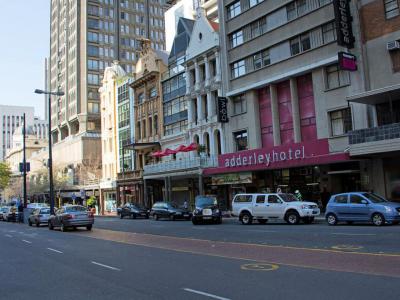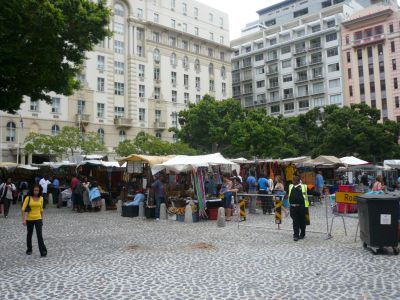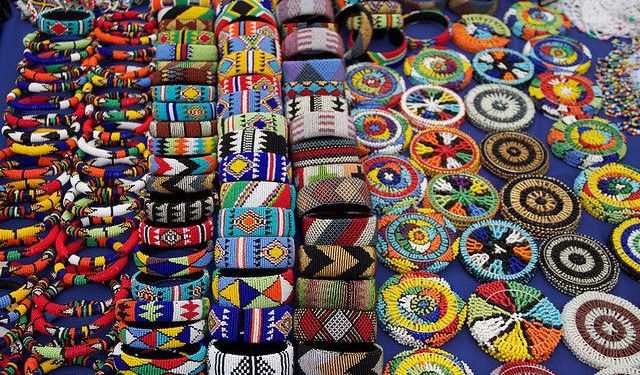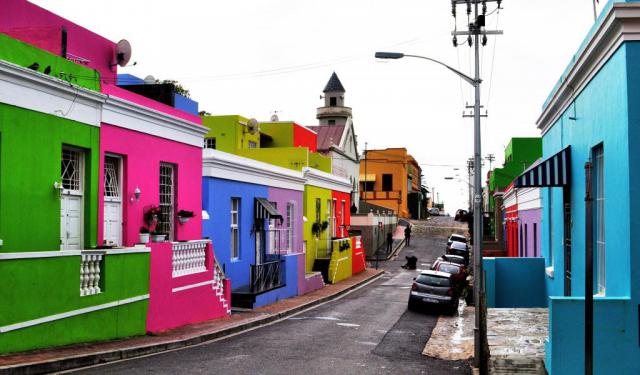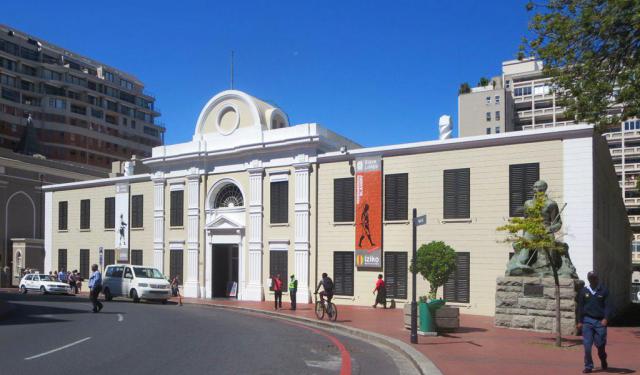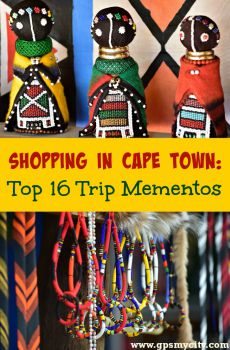Cape Town Introduction Walking Tour (Self Guided), Cape Town
Portuguese explorer Bartolomeu Dias first mentioned the Cape of Storms in 1488, but it was soon renamed the Cape of Good Hope with an optimistic eye towards the trade routes it offered between Europe and the East.
In 1652, the Dutch East India Company settled a way-station here for ships traveling that route. Cape Town's natural harbor and strategic position made it the perfect location. You can see the harbor that was so attractive, now known as the Victoria & Alfred Waterfront. You can also tour the Castle of Good Hope, the East India Company's original settlement. The Company's Garden is also still here, where supplies were grown for passing ships and the permanent settlers.
The colonial powers fought over Cape Town and the surrounding lands throughout the late 1700 and early 1800s, and control oscillated between the Dutch and the British. The UK eventually won out, but Cape had its own parliament and local Prime Minister by 1872.
Discoveries of gold and diamonds in the areas nearby led to substantial population booms throughout the 1800s.
Before the 1948 apartheid, Cape Town was one of the most integrated cities in South Africa. Unfortunately, apartheid abolished this multiculturalism. Entire city suburbs were demolished in the effort. You can learn more about the history and story at the District Six Museum.
Today, Cape Town is the legislative capital of the independent and integrated Republic of South Africa. It is the nation's second-largest city behind Johannesburg. Cape Town has regularly been voted one of the best cities to visit, and in 2014 it was named a World Design Capital. Join us on a walking tour of this lovely seaside port, with beautiful views of Table Mountain and the Cape of Good Hope, as well as a dynamic and diverse population of friendly people.
In 1652, the Dutch East India Company settled a way-station here for ships traveling that route. Cape Town's natural harbor and strategic position made it the perfect location. You can see the harbor that was so attractive, now known as the Victoria & Alfred Waterfront. You can also tour the Castle of Good Hope, the East India Company's original settlement. The Company's Garden is also still here, where supplies were grown for passing ships and the permanent settlers.
The colonial powers fought over Cape Town and the surrounding lands throughout the late 1700 and early 1800s, and control oscillated between the Dutch and the British. The UK eventually won out, but Cape had its own parliament and local Prime Minister by 1872.
Discoveries of gold and diamonds in the areas nearby led to substantial population booms throughout the 1800s.
Before the 1948 apartheid, Cape Town was one of the most integrated cities in South Africa. Unfortunately, apartheid abolished this multiculturalism. Entire city suburbs were demolished in the effort. You can learn more about the history and story at the District Six Museum.
Today, Cape Town is the legislative capital of the independent and integrated Republic of South Africa. It is the nation's second-largest city behind Johannesburg. Cape Town has regularly been voted one of the best cities to visit, and in 2014 it was named a World Design Capital. Join us on a walking tour of this lovely seaside port, with beautiful views of Table Mountain and the Cape of Good Hope, as well as a dynamic and diverse population of friendly people.
How it works: Download the app "GPSmyCity: Walks in 1K+ Cities" from Apple App Store or Google Play Store to your mobile phone or tablet. The app turns your mobile device into a personal tour guide and its built-in GPS navigation functions guide you from one tour stop to next. The app works offline, so no data plan is needed when traveling abroad.
Cape Town Introduction Walking Tour Map
Guide Name: Cape Town Introduction Walking Tour
Guide Location: South Africa » Cape Town (See other walking tours in Cape Town)
Guide Type: Self-guided Walking Tour (Sightseeing)
# of Attractions: 9
Tour Duration: 1 Hour(s)
Travel Distance: 2.1 Km or 1.3 Miles
Author: DanaOffice
Sight(s) Featured in This Guide:
Guide Location: South Africa » Cape Town (See other walking tours in Cape Town)
Guide Type: Self-guided Walking Tour (Sightseeing)
# of Attractions: 9
Tour Duration: 1 Hour(s)
Travel Distance: 2.1 Km or 1.3 Miles
Author: DanaOffice
Sight(s) Featured in This Guide:
- City Hall
- Castle of Good Hope
- District Six Museum
- Parliament Building of South Africa
- Company's Garden
- St. George's Cathedral
- Slave Lodge
- Adderley Street
- Greenmarket Square
1) City Hall (must see)
City Hall is a sizeable Edwardian-style building that was built in 1905. It is constructed from light-colored limestone imported from Bath, England.
One of the most impressive things about City Hall is its massive organ. The design for the organ was created by Saint Paul Catherdral's organist, Sir George Martin. The organ has an impressive 3,165 pipes, ranging in size from three-quarters of an inch to 32 feet.
The turret clock, or tower clock, dominates the center of the building. It's half the size of London's famous Big Ben clock and strikes the hour and chimes the quarters.
The carillon, a set of tower bells, was installed as a World War I memorial. An additional 22 bells were installed to celebrate the Prince of Wales's visit in 1925. The carillon has a total of 39 bells and is the only active carillon in South Africa. It is played by a complicated set of wooden levers and pedals.
On February 11, 1990, Nelson Mandela was released from prison. He gave his first public address from the balcony of City Hall. In 2018, a statue of Nelson Mandela was placed on the balcony as a memorial.
The city offices are now located in the Cape Town Civic Center. Today, City Hall is used for events, art exhibitions, and concerts. One of the most popular events is the annual holiday Festive Lights Switch On.
One of the most impressive things about City Hall is its massive organ. The design for the organ was created by Saint Paul Catherdral's organist, Sir George Martin. The organ has an impressive 3,165 pipes, ranging in size from three-quarters of an inch to 32 feet.
The turret clock, or tower clock, dominates the center of the building. It's half the size of London's famous Big Ben clock and strikes the hour and chimes the quarters.
The carillon, a set of tower bells, was installed as a World War I memorial. An additional 22 bells were installed to celebrate the Prince of Wales's visit in 1925. The carillon has a total of 39 bells and is the only active carillon in South Africa. It is played by a complicated set of wooden levers and pedals.
On February 11, 1990, Nelson Mandela was released from prison. He gave his first public address from the balcony of City Hall. In 2018, a statue of Nelson Mandela was placed on the balcony as a memorial.
The city offices are now located in the Cape Town Civic Center. Today, City Hall is used for events, art exhibitions, and concerts. One of the most popular events is the annual holiday Festive Lights Switch On.
2) Castle of Good Hope (must see)
The Castle of Good Hope is also known as The Castle or Cape Town Castle. The Castle is a stone fort in the shape of a pentagram and is the oldest existing structure in Cape Town. The Dutch East India Company built it between 1666 and 1679. The Dutch had established a settlement here to serve as a supply stop for the Dutch East India Company as it sailed between the Netherlands and Indonesia, which was then known as the East Indies.
When rumors of war between England and the Netherlands circulated, the Dutch East India Company decided to build a fortress to protect this strategic location.
The gated entry replaced the old entrance in 1682. A bell tower was added in 1684. The Castle originally overlooked Table Bay. After a land reclamation effort, it is now further inland.
Part of The Castle was used as a prison during the Second Boer War, and the cells remain to this day. The Castle is a provincial heritage site and is known as the best-preserved Dutch East India Fort.
Complete guided tours of the fort are available. Visitors can attend a Key Ceremony and the popular canon firing. The Castle is also home to three museums, a gift shop, and a restaurant.
Why You Should Visit:
The guided tour is informative and funny and will end up as one of the highlights of your visit to Cape Town.
The views of the city and Table Mountain from the (walkable) ramparts are very good.
Tip:
The changing of the guard doesn't rival Buckingham Palace but as a side treat, there's a cannon firing on the hour at 11:00/12:00. Please note: Key Ceremony runs Mon–Fri and Cannon Firing does not take place on Sundays. These ceremonies are also weather dependent.
When rumors of war between England and the Netherlands circulated, the Dutch East India Company decided to build a fortress to protect this strategic location.
The gated entry replaced the old entrance in 1682. A bell tower was added in 1684. The Castle originally overlooked Table Bay. After a land reclamation effort, it is now further inland.
Part of The Castle was used as a prison during the Second Boer War, and the cells remain to this day. The Castle is a provincial heritage site and is known as the best-preserved Dutch East India Fort.
Complete guided tours of the fort are available. Visitors can attend a Key Ceremony and the popular canon firing. The Castle is also home to three museums, a gift shop, and a restaurant.
Why You Should Visit:
The guided tour is informative and funny and will end up as one of the highlights of your visit to Cape Town.
The views of the city and Table Mountain from the (walkable) ramparts are very good.
Tip:
The changing of the guard doesn't rival Buckingham Palace but as a side treat, there's a cannon firing on the hour at 11:00/12:00. Please note: Key Ceremony runs Mon–Fri and Cannon Firing does not take place on Sundays. These ceremonies are also weather dependent.
3) District Six Museum (must see)
The District Six Museum, situated in Cape Town, stands as a reminder of the forced displacement of 60,000 inhabitants during the apartheid era in the 1970s. This museum, which found its home in an old Methodist church, is deeply rooted in the history of the former inner-city residential area known as District Six. Established by the District Six Foundation in 1994, five years after the foundation's inception in 1989, the museum serves as a memorial to the diverse community that once thrived in District Six before their lives were irrevocably changed by apartheid's cruel policies.
At the heart of the museum is a large map of the district laid out on the floor, annotated with handwritten notes by former residents. These notes mark the locations of their former homes, bringing a personal touch to the history depicted. Among these residents was the celebrated jazz musician Abdullah Ibrahim, also known as Dollar Brand, highlighting the rich cultural heritage that characterized the district. The museum also houses a collection of other significant items such as old traffic signs, exhibits that capture historical moments and the lives of families from the area, historical declarations, and exhibits detailing the demolition of the district.
Beyond its role as a keeper of memory, the District Six Museum actively engages with the present and future of the area. It offers programs aimed at the development of the district, involving current inhabitants in the construction of housing, environmental planning, and the organization of music, literature, and art activities. This engagement is part of the museum's broader goal to foster a community where dignity, identity, and the co-existence of different races are respected.
The museum's significant contribution to preserving cultural heritage and promoting reconciliation was recognized internationally when it received the Prince Claus Award from the Netherlands in 2003. This accolade underscores the museum's importance not only as a site of memory but also as a space for healing and rebuilding.
Why You Should Visit:
Well worth taking a guided tour to get a real understanding of the evil that was apartheid. The guides are former residents (before they were kicked out in 1966).
Tip:
Get there early and take a break at their coffee shop – it's very nice and you must try their samosas and/or koeksisters!
At the heart of the museum is a large map of the district laid out on the floor, annotated with handwritten notes by former residents. These notes mark the locations of their former homes, bringing a personal touch to the history depicted. Among these residents was the celebrated jazz musician Abdullah Ibrahim, also known as Dollar Brand, highlighting the rich cultural heritage that characterized the district. The museum also houses a collection of other significant items such as old traffic signs, exhibits that capture historical moments and the lives of families from the area, historical declarations, and exhibits detailing the demolition of the district.
Beyond its role as a keeper of memory, the District Six Museum actively engages with the present and future of the area. It offers programs aimed at the development of the district, involving current inhabitants in the construction of housing, environmental planning, and the organization of music, literature, and art activities. This engagement is part of the museum's broader goal to foster a community where dignity, identity, and the co-existence of different races are respected.
The museum's significant contribution to preserving cultural heritage and promoting reconciliation was recognized internationally when it received the Prince Claus Award from the Netherlands in 2003. This accolade underscores the museum's importance not only as a site of memory but also as a space for healing and rebuilding.
Why You Should Visit:
Well worth taking a guided tour to get a real understanding of the evil that was apartheid. The guides are former residents (before they were kicked out in 1966).
Tip:
Get there early and take a break at their coffee shop – it's very nice and you must try their samosas and/or koeksisters!
4) Parliament Building of South Africa
While in Cape Town don’t pass up the opportunity to visit the Parliament of South Africa, which holds guided tours on most weekdays when Parliament isn’t in session, or you can get tickets to sit in the public gallery when the Parliament is in session.
Since 1910 Cape Town has been the Legislative Capital of the Union and the Council of Provinces meet in the Old House of Parliament which was built in 1885. The National Assembly meets in the Tricameral Chamber, which was created when colored members were admitted to the government.
The building was originally designed by Charles Freeman in 1875, but the design was later found flawed and Freeman got kicked off the project which was then handed to Henry Greaves, who re-did the plans and the building was finished in 1884.
There are two entrances to this beautiful building – one on the garden side with six Corinthian columns; the other, the main entrance on Parliament Street, has four groups of two columns. In front of this entrance, you will see a grand statue of Queen Victoria.
The guided tours are a great way to learn the history of South Africa. They start by visiting the multimedia room where you will watch a short documentary DVD that explains the history of the National Symbol and the Parliamentary Emblem. The guides are always ready to answer any questions concerning the political history of South Africa.
Tip:
Photography is strictly forbidden inside the building. Guided tours available, but those need to be pre-booked.
Since 1910 Cape Town has been the Legislative Capital of the Union and the Council of Provinces meet in the Old House of Parliament which was built in 1885. The National Assembly meets in the Tricameral Chamber, which was created when colored members were admitted to the government.
The building was originally designed by Charles Freeman in 1875, but the design was later found flawed and Freeman got kicked off the project which was then handed to Henry Greaves, who re-did the plans and the building was finished in 1884.
There are two entrances to this beautiful building – one on the garden side with six Corinthian columns; the other, the main entrance on Parliament Street, has four groups of two columns. In front of this entrance, you will see a grand statue of Queen Victoria.
The guided tours are a great way to learn the history of South Africa. They start by visiting the multimedia room where you will watch a short documentary DVD that explains the history of the National Symbol and the Parliamentary Emblem. The guides are always ready to answer any questions concerning the political history of South Africa.
Tip:
Photography is strictly forbidden inside the building. Guided tours available, but those need to be pre-booked.
5) Company's Garden
The Company's Garden was created in the 1650s and is the oldest garden in South Africa. European settlers established the garden to grow fresh produce for themselves and resupply ships. By 1653 the garden enabled the settlers to be self-sustaining.
Today, the Company's Garden is a beautiful spot to relax and enjoy this fantastic green space in the heart of the city.
The Garden hosts the South African Museum, the Cape Town Holocaust Centre, and the South African National Gallery.
There are many interesting features in the Company Garden. A pear tree planted in 1652 is still growing in the garden and is the oldest cultivated tree in South Africa. The Rutherford fountain was placed here in 1864. Visitors will be fascinated by the well pump embedded in an oak tree; it was placed here in 1842.
The bamboo plantation is over 150 years old, and there are distinctive trees like a Ginko tree and a rubber tree. Additionally, you'll see a stocked fish pond, numerous fountains, and several important memorials.
There's also a host of animals that call The Company's Garden home. The squirrels are popular, especially with children, and you can buy bags of nuts to feed them. An aviary has dozens of bird species. Visitors will also spot geese and herons around the garden.
A popular restaurant is located on-site. Visitors can also find local arts and crafts being sold along the avenue. The Company's Garden is shaded and a great way to spend a hot day.
Today, the Company's Garden is a beautiful spot to relax and enjoy this fantastic green space in the heart of the city.
The Garden hosts the South African Museum, the Cape Town Holocaust Centre, and the South African National Gallery.
There are many interesting features in the Company Garden. A pear tree planted in 1652 is still growing in the garden and is the oldest cultivated tree in South Africa. The Rutherford fountain was placed here in 1864. Visitors will be fascinated by the well pump embedded in an oak tree; it was placed here in 1842.
The bamboo plantation is over 150 years old, and there are distinctive trees like a Ginko tree and a rubber tree. Additionally, you'll see a stocked fish pond, numerous fountains, and several important memorials.
There's also a host of animals that call The Company's Garden home. The squirrels are popular, especially with children, and you can buy bags of nuts to feed them. An aviary has dozens of bird species. Visitors will also spot geese and herons around the garden.
A popular restaurant is located on-site. Visitors can also find local arts and crafts being sold along the avenue. The Company's Garden is shaded and a great way to spend a hot day.
6) St. George's Cathedral
Saint George’s Cathedral on Wale Street is renowned for two things: the first is its beautiful stained glass windows; the second is that even after 120 years, it still isn’t finished!
The cathedral was designed on the site of a former church by Sir Henry Baker in 1901. Building started in 1906, but due to a lack of funds, the North Transept wasn’t finished until 1936. By this time Sir Henry had returned to England, where he died ten years later.
Work dragged on slowly over the years. The Lady Chapel and the south aisle were completed in 1963, the Bell Tower and the Link in 1978. The cathedral is still waiting for the Chapter House to be added onto the end of the Link.
In 1982 the French stained-glass artist Gabriel Loire donated the magnificent window entitled “Christ in Triumph over Darkness and Evil” to the cathedral. This masterpiece is dedicated to the memory of Earl Mountbatten of Burma, the last Viceroy of India. The beautiful rose window is in the South Transept and in the Link is a window dating back to 1866 of the Last Supper.
In the cathedral gardens, you can walk the Labyrinth and buy souvenirs in the Cathedral Book and Bric-à-Brac Shop opposite the church. This great shop not only sells religious books but also cookbooks, children’s stories, and fiction. You can browse through the CDs or old records, pictures and paintings, antiques and occasionally small items of furniture.
Tip:
Be sure to visit the crypt and the beautiful wooden homage to Archbishop Desmond Tutu at the entrance leading to the Company Garden.
The cathedral was designed on the site of a former church by Sir Henry Baker in 1901. Building started in 1906, but due to a lack of funds, the North Transept wasn’t finished until 1936. By this time Sir Henry had returned to England, where he died ten years later.
Work dragged on slowly over the years. The Lady Chapel and the south aisle were completed in 1963, the Bell Tower and the Link in 1978. The cathedral is still waiting for the Chapter House to be added onto the end of the Link.
In 1982 the French stained-glass artist Gabriel Loire donated the magnificent window entitled “Christ in Triumph over Darkness and Evil” to the cathedral. This masterpiece is dedicated to the memory of Earl Mountbatten of Burma, the last Viceroy of India. The beautiful rose window is in the South Transept and in the Link is a window dating back to 1866 of the Last Supper.
In the cathedral gardens, you can walk the Labyrinth and buy souvenirs in the Cathedral Book and Bric-à-Brac Shop opposite the church. This great shop not only sells religious books but also cookbooks, children’s stories, and fiction. You can browse through the CDs or old records, pictures and paintings, antiques and occasionally small items of furniture.
Tip:
Be sure to visit the crypt and the beautiful wooden homage to Archbishop Desmond Tutu at the entrance leading to the Company Garden.
7) Slave Lodge
The Slave Lodge is located on the corner of Wale and Adderley Streets and is an interesting museum to visit as it pays tribute to the thousands of slaves brought to Cape Town between the 17th and 19th centuries.
The lodge was built in 1679 and it was here that the Dutch East India Company housed up to a thousand slaves in unsanitary, cramped conditions. The original lodge had no windows and was built of unadorned brick, but today it is a smart, white-washed building that tells the story of the African and Asian slaves who lived and worked in the city.
Through interactive displays, you will learn about slave family roots, their way of life and how some of them settled in the city after winning their freedom.
The museum has a small but excellent collection of Egyptian artifacts that date back to 3050BC, including silver items, textiles, toys, and tools. You can admire a superb collection of Greek vases and ceramics, pottery and cuneiform tablets from the Roman occupation of the Near East.
Between 1811 and 1911 the lodge changed hands several times: it was a post office, a public library, a small prison, and the Supreme Court. In the courtyard, you will see the tombstones (but not the graves) of Cape Town’s founder, Jan Van Riebeeck and his wife Maria.
The lodge was built in 1679 and it was here that the Dutch East India Company housed up to a thousand slaves in unsanitary, cramped conditions. The original lodge had no windows and was built of unadorned brick, but today it is a smart, white-washed building that tells the story of the African and Asian slaves who lived and worked in the city.
Through interactive displays, you will learn about slave family roots, their way of life and how some of them settled in the city after winning their freedom.
The museum has a small but excellent collection of Egyptian artifacts that date back to 3050BC, including silver items, textiles, toys, and tools. You can admire a superb collection of Greek vases and ceramics, pottery and cuneiform tablets from the Roman occupation of the Near East.
Between 1811 and 1911 the lodge changed hands several times: it was a post office, a public library, a small prison, and the Supreme Court. In the courtyard, you will see the tombstones (but not the graves) of Cape Town’s founder, Jan Van Riebeeck and his wife Maria.
8) Adderley Street
If you want to do some up market shopping, you should go to Adderley Street, which is the main street in Cape Town’s downtown district.
The street runs from Heerengracht to the entrance of Company Gardens, after which it becomes Government Avenue. It was named after the British Member of Parliament, Charles Bowyer Adderley, who fought against the British Government’s plans to turn the Cape are into a penal colony like Australia.
The street is full of shops, restaurants and offices. At night markets flourish and during the day a permanent market in the square in front of Central Station sells leather goods and curios. You will also find the famous Flower Market where freshly cut flowers have been sold on this spot for over 100 years.
Along the street there is the entrance to the Golden Acre, which is the oldest shopping center in South Africa. Another building of note is the Groote Kerk on Church Square. At the end of the street you will discover the Slave Lodge Museum.
In front of the museum’s entrance is a statue of Jan Smuts, who was a member of the British War Cabinet and who helped create the Royal Air Force. From 1919 to 1924 and from 1939 to 1948 he was the Prime Minister of the Union of South Africa.
The street runs from Heerengracht to the entrance of Company Gardens, after which it becomes Government Avenue. It was named after the British Member of Parliament, Charles Bowyer Adderley, who fought against the British Government’s plans to turn the Cape are into a penal colony like Australia.
The street is full of shops, restaurants and offices. At night markets flourish and during the day a permanent market in the square in front of Central Station sells leather goods and curios. You will also find the famous Flower Market where freshly cut flowers have been sold on this spot for over 100 years.
Along the street there is the entrance to the Golden Acre, which is the oldest shopping center in South Africa. Another building of note is the Groote Kerk on Church Square. At the end of the street you will discover the Slave Lodge Museum.
In front of the museum’s entrance is a statue of Jan Smuts, who was a member of the British War Cabinet and who helped create the Royal Air Force. From 1919 to 1924 and from 1939 to 1948 he was the Prime Minister of the Union of South Africa.
9) Greenmarket Square (must see)
Greenmarket Square, nestled in the heart of Cape Town's Central Business District, is a vibrant and historical marketplace that has evolved through various incarnations over the years. From its early days as a slave market to serving as a fruit and vegetable market, and even functioning as a parking lot, today it stands as a bustling flea market cherished by both locals and tourists alike.
The square offers a unique shopping experience, with its ancient cobblestones adding to the charm and providing a stark contrast to the dynamic, cosmopolitan vibe of Cape Town. The market is renowned for its wide array of informal traders who showcase a diverse range of merchandise that reflects the rich tapestry of African traditions. Shoppers can find an assortment of goods such as batiks, beadwork, sculptures, glassware, jewelry, clothing, footwear, music CDs, sunglasses, and paintings, all offered at reasonable prices.
One of the defining features of Greenmarket Square is the blend of cross-continental merchandise, which includes items from various African cultures like the Masai, Xhosa, Zulu, and the Bade tribe from Senegal. This melting pot of cultures not only offers a glimpse into the continent's diverse heritage but also allows for a shopping experience that is both adventurous and educational.
The square is not just about shopping; it's also a place where visitors can engage with the friendly, vibrant vendors who embody the diverse cultures of Cape Town. The atmosphere is further enlivened by entertainers such as buskers, drummers, jugglers, and mime artists, who add to the lively ambiance and make shopping at Greenmarket Square an unforgettable experience.
Adding to the square's appeal are the surrounding restaurants and cafés, where visitors can savor delicious local dishes and drinks. The location of Greenmarket Square is also a significant draw, as it is situated within walking distance from several key historical and cultural landmarks, including the Company Gardens, Houses of Parliament, South African Museum, Pan African Market, Castle of Good Hope, and the Old Town House, which showcases early Cape Dutch architecture and houses an important collection of Dutch and Flemish Masters' artworks.
Why You Should Visit:
Not for people looking for peace – it's a fun place to sit outside under the sun with a drink/snack and watch the activity. It's also a good place to find your souvenirs.
Tip:
As with most markets, prices vary wildly so always bargain the price. Take cash and be prepared to haggle to get a good deal.
Don't forget to visit the small, pedestrian-only streets around the Greenmarket, but be cautious/aware of your surroundings after dark.
The square offers a unique shopping experience, with its ancient cobblestones adding to the charm and providing a stark contrast to the dynamic, cosmopolitan vibe of Cape Town. The market is renowned for its wide array of informal traders who showcase a diverse range of merchandise that reflects the rich tapestry of African traditions. Shoppers can find an assortment of goods such as batiks, beadwork, sculptures, glassware, jewelry, clothing, footwear, music CDs, sunglasses, and paintings, all offered at reasonable prices.
One of the defining features of Greenmarket Square is the blend of cross-continental merchandise, which includes items from various African cultures like the Masai, Xhosa, Zulu, and the Bade tribe from Senegal. This melting pot of cultures not only offers a glimpse into the continent's diverse heritage but also allows for a shopping experience that is both adventurous and educational.
The square is not just about shopping; it's also a place where visitors can engage with the friendly, vibrant vendors who embody the diverse cultures of Cape Town. The atmosphere is further enlivened by entertainers such as buskers, drummers, jugglers, and mime artists, who add to the lively ambiance and make shopping at Greenmarket Square an unforgettable experience.
Adding to the square's appeal are the surrounding restaurants and cafés, where visitors can savor delicious local dishes and drinks. The location of Greenmarket Square is also a significant draw, as it is situated within walking distance from several key historical and cultural landmarks, including the Company Gardens, Houses of Parliament, South African Museum, Pan African Market, Castle of Good Hope, and the Old Town House, which showcases early Cape Dutch architecture and houses an important collection of Dutch and Flemish Masters' artworks.
Why You Should Visit:
Not for people looking for peace – it's a fun place to sit outside under the sun with a drink/snack and watch the activity. It's also a good place to find your souvenirs.
Tip:
As with most markets, prices vary wildly so always bargain the price. Take cash and be prepared to haggle to get a good deal.
Don't forget to visit the small, pedestrian-only streets around the Greenmarket, but be cautious/aware of your surroundings after dark.
Walking Tours in Cape Town, South Africa
Create Your Own Walk in Cape Town
Creating your own self-guided walk in Cape Town is easy and fun. Choose the city attractions that you want to see and a walk route map will be created just for you. You can even set your hotel as the start point of the walk.
Cape Town Shopping Tour
Cape Town is grand with quality shopping. The available options here, such as South Africa's top flea market where you can find a wealth of merchandise, from tribal costumes to precious jewelry, offer a colorful experience for both locals and tourists.
Among the standout locations in Cape Town that shoppers particularly love to explore is Adderley Street. This bustling thoroughfare is... view more
Tour Duration: 1 Hour(s)
Travel Distance: 0.4 Km or 0.2 Miles
Among the standout locations in Cape Town that shoppers particularly love to explore is Adderley Street. This bustling thoroughfare is... view more
Tour Duration: 1 Hour(s)
Travel Distance: 0.4 Km or 0.2 Miles
Bo-Kaap Quarter Walking Tour
Bo-Kaap is Afrikaans for "above the Cape." The Bo-Kaap District is above Cape Town's city center, on the slopes of Signal Hill. It is the historical center of Cape Malay culture. In the 1760s, Jan de Waal bought land here and built houses he rented to his slaves.
Slaves came from Malaysia, Indonesia, and other parts of Africa. Many of these slaves were Muslim, and this area... view more
Tour Duration: 1 Hour(s)
Travel Distance: 1.0 Km or 0.6 Miles
Slaves came from Malaysia, Indonesia, and other parts of Africa. Many of these slaves were Muslim, and this area... view more
Tour Duration: 1 Hour(s)
Travel Distance: 1.0 Km or 0.6 Miles
Historical Houses Walking Tour
When Jan van Riebeeck arrived in Cape Town in 1652, his mission was to establish here a supply station for the ships of the Dutch East India Company sailing to East Africa, India, and the Far East. The oldest buildings in today's Cape Town, dating from the second half of the 17th century, are the remnants of that era.
Garden House, originally a shabby tool shed owned by the Dutch East... view more
Tour Duration: 1 Hour(s)
Travel Distance: 2.8 Km or 1.7 Miles
Garden House, originally a shabby tool shed owned by the Dutch East... view more
Tour Duration: 1 Hour(s)
Travel Distance: 2.8 Km or 1.7 Miles
Useful Travel Guides for Planning Your Trip
16 Distinctively South African Things to Buy in Cape Town
The many hopes pinned on this place (Cape of Good Hope) by passing-by sailors over the centuries must have done a good job for Cape Town, seeing it become a colorful cultural hub and prominent metropolis (3rd largest) in South Africa. Overlooking the meeting point of the two oceans (Indian and...
The Most Popular Cities
/ view all
